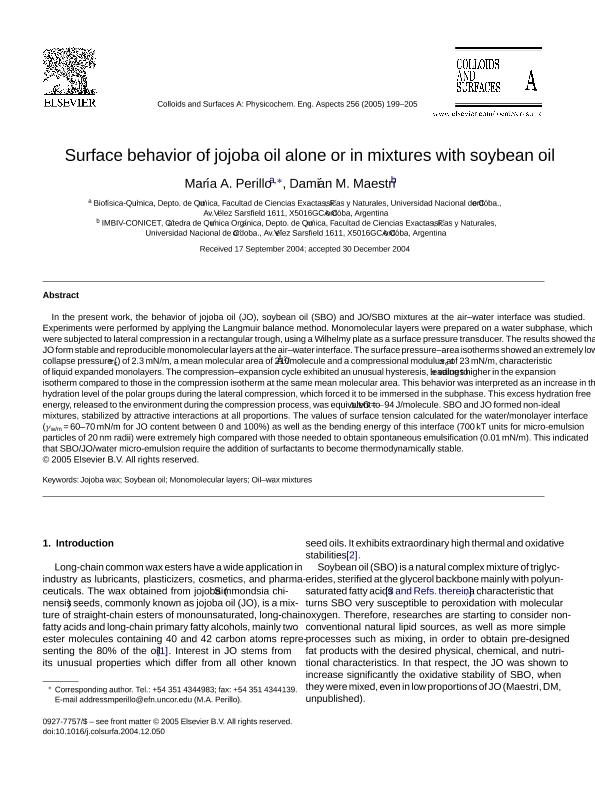Mostrar el registro sencillo del ítem
dc.contributor.author
Perillo, Maria Angelica

dc.contributor.author
Maestri, Damian

dc.date.available
2017-12-07T14:16:18Z
dc.date.issued
2005-04
dc.identifier.citation
Perillo, Maria Angelica; Maestri, Damian; Surface behavior of jojoba oil alone or in mixtures with soybean oil; Elsevier Science; Colloids and Surfaces A: Physicochemical and Engineering Aspects; 256; 2-3; 4-2005; 199-205
dc.identifier.issn
0927-7757
dc.identifier.uri
http://hdl.handle.net/11336/29901
dc.description.abstract
In the present work, the behavior of jojoba oil (JO), soybean oil (SBO) and JO/SBO mixtures at the air–water interface was studied. Experiments were performed by applying the Langmuir balance method. Monomolecular layers were prepared on a water subphase, which were subjected to lateral compression in a rectangular trough, using a Wilhelmy plate as a surface pressure transducer. The results showed that JO form stable and reproducible monomolecular layers at the air–water interface. The surface pressure–area isotherms showed an extremely low collapse pressure (πc) of 2.3 mN/m, a mean molecular area of 210 Å2/molecule and a compressional modulus at πc of 23 mN/m, characteristic of liquid expanded monolayers. The compression–expansion cycle exhibited an unusual hysteresis, leading to π values higher in the expansion isotherm compared to those in the compression isotherm at the same mean molecular area. This behavior was interpreted as an increase in the hydration level of the polar groups during the lateral compression, which forced it to be immersed in the subphase. This excess hydration free energy, released to the environment during the compression process, was equivalent to ΔΔG = −94 J/molecule. SBO and JO formed non-ideal mixtures, stabilized by attractive interactions at all proportions. The values of surface tension calculated for the water/monolayer interface (γw/m = 60–70 mN/m for JO content between 0 and 100%) as well as the bending energy of this interface (700 kT units for micro-emulsion particles of 20 nm radii) were extremely high compared with those needed to obtain spontaneous emulsification (0.01 mN/m). This indicated that SBO/JO/water micro-emulsion require the addition of surfactants to become thermodynamically stable.
dc.format
application/pdf
dc.language.iso
eng
dc.publisher
Elsevier Science

dc.rights
info:eu-repo/semantics/openAccess
dc.rights.uri
https://creativecommons.org/licenses/by-nc-sa/2.5/ar/
dc.subject
Jojoba Wax
dc.subject
Soybean Oil
dc.subject
Monolecular Layers
dc.subject.classification
Otras Ciencias Biológicas

dc.subject.classification
Ciencias Biológicas

dc.subject.classification
CIENCIAS NATURALES Y EXACTAS

dc.title
Surface behavior of jojoba oil alone or in mixtures with soybean oil
dc.type
info:eu-repo/semantics/article
dc.type
info:ar-repo/semantics/artículo
dc.type
info:eu-repo/semantics/publishedVersion
dc.date.updated
2017-11-16T15:25:35Z
dc.journal.volume
256
dc.journal.number
2-3
dc.journal.pagination
199-205
dc.journal.pais
Países Bajos

dc.journal.ciudad
Amsterdam
dc.description.fil
Fil: Perillo, Maria Angelica. Consejo Nacional de Investigaciones Científicas y Técnicas. Centro Científico Tecnológico Conicet - Córdoba. Instituto de Investigaciones Biológicas y Tecnológicas. Universidad Nacional de Córdoba. Facultad de Ciencias Exactas, Físicas y Naturales. Instituto de Investigaciones Biológicas y Tecnológicas; Argentina. Universidad Nacional de Córdoba. Facultad de Ciencias Exactas, Físicas y Naturales. Departamento de Química. Cátedra de Biofísica Química; Argentina
dc.description.fil
Fil: Maestri, Damian. Consejo Nacional de Investigaciones Científicas y Técnicas. Centro Científico Tecnológico Conicet - Córdoba. Instituto Multidisciplinario de Biología Vegetal. Universidad Nacional de Córdoba. Facultad de Ciencias Exactas Físicas y Naturales. Instituto Multidisciplinario de Biología Vegetal; Argentina. Universidad Nacional de Córdoba. Facultad de Ciencias Exactas, Físicas y Naturales. Departamento de Química. Cátedra de Química Organica; Argentina
dc.journal.title
Colloids and Surfaces A: Physicochemical and Engineering Aspects

dc.relation.alternativeid
info:eu-repo/semantics/altIdentifier/url/https://www.sciencedirect.com/science/article/pii/S092777570500004X
dc.relation.alternativeid
info:eu-repo/semantics/altIdentifier/doi/https://doi.org/10.1016/j.colsurfa.2004.12.050
Archivos asociados
